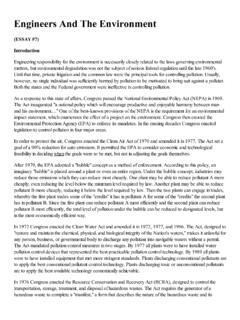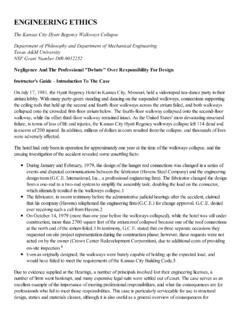Transcription of ENGINEERING ETHICS
1 ENGINEERING ETHICSThe space shuttle challenger DisasterDepartment of Philosophy and Department of Mechanical ENGINEERING Texas A&M University NSF Grant Number DIR-9012252 Instructor's GuideIntroduction To The CaseOn January 28, 1986, seven astronauts were killed when the space shuttle they were piloting, the challenger ,exploded just over a minute into the flight. The failure of the solid rocket booster O-rings to seat properlyallowed hot combustion gases to leak from the side of the booster and burn through the external fuel tank. Thefailure of the O-ring was attributed to several factors, including faulty design of the solid rocket boosters,insufficient low- temperature testing of the O-ring material and the joints that the O-ring sealed, and lack ofproper communication between different levels of NASA GuidelinesPrior to class discussion, ask the students to read the student handout outside of class. In class the details of thecase can be reviewed with the aide of the overheads.
2 Reserve about half of the class period for an opendiscussion of the issues. The issues covered in the student handout include the importance of an engineer'sresponsibility to public welfare, the need for this responsibility to hold precedence over any other responsibilitiesthe engineer might have and the responsibilities of a manager/engineer. A final point is the fact that no matter howfar removed from the public an engineer may think she is, all of her actions have potential impact. Essay #6,"Loyalty and Professional Rights" appended at the end of the case listings in this report will be found relevant forinstructors preparing to lead class discussion on this case. In addition, essays #1 through #4 appended at the endof the cases in this report will have relevant background information for the instructor preparing to leadclassroom discussion. Their titles are, respectively: " ETHICS and Professionalism in ENGINEERING : Why the Interest inEngineering ETHICS ?
3 ;" "Basic Concepts and Methods in ETHICS ," "Moral Concepts and Theories," and" ENGINEERING Design: Literature on Social Responsibility Versus Legal Liability."Questions for Class Discussion1. What could NASA management have done differently?2. What, if anything, could their subordinates have done differently?3. What should Roger Boisjoly have done differently (if anything)? In answering this question, keep in mindthat at his age, the prospect of finding a new job if he was fired was slim. He also had a family to What do you (the students) see as your future ENGINEERING professional responsibilities in relation to bothbeing loyal to management and protecting the public welfare?The challenger Disaster Overheads1. Organizations/People Involved2. Key Dates3. space shuttle Solid Rocket Boosters (SRB) Joints4. Detail of SRB Field Joints5. Ballooning Effect of Motor Casing6. Key IssuesORGANIZATIONS/PEOPLE INVOLVEDM arshall space Flight Center - in charge of booster rocket development Larry Mulloy - challenged the engineers' decision not to launch Morton Thiokol - Contracted by NASA to build the Solid Rocket Booster Alan McDonald - Director of the Solid Rocket Motors Project Bob Lund - ENGINEERING Vice President Robert Ebeling - Engineer who worked under McDonald Roger Boisjoly - Engineer who worked under McDonald Joe Kilminster - Engineer in a management position Jerald Mason - Senior executive who encouraged Lund to reassess his decision not to DATES1974 - Morton-Thiokol awarded contract to build solid rocket boosters.
4 1976 - NASA accepts Morton-Thiokol's booster design. 1977 - Morton-Thiokol discovers joint rotation problem. November 1981 - O-ring erosiondiscovered after second shuttle flight. January 24, 1985 - shuttle flight that exhibited the worst O-ring blow-by. July 1985 - Thiokol orders new steel billets for new field joint design. August 19, 1985 - NASA Level I management briefed on booster problem. January 27, 1986 - night teleconference to discuss effects of cold temperature on boosterperformance. January 28, 1986 - challenger explodes 72 seconds after ISSUESHOW DOES THE IMPLIED SOCIAL CONTRACT OF PROFESSIONALS APPLY TOTHIS CASE? WHAT PROFESSIONAL RESPONSIBILITIES WERE NEGLECTED, IF ANY? SHOULD NASA HAVE DONE ANYTHING DIFFERENTLY IN THEIR LAUNCHDECISION PROCEDURE?Student Handout - SynopsisOn January 28, 1986, seven astronauts were killed when the space shuttle they were piloting, the challenger ,exploded just over a minute into flight. The failure of the solid rocket booster O-rings to seat properly allowedhot combustion gases to leak from the side of the booster and burn through the external fuel tank.
5 The failure ofthe O-ring was attributed to several factors, including faulty design of the solid rocket boosters, insufficient lowtemperature testing of the O-ring material and the joints that the O-ring sealed, and lack of communicationbetween different levels of NASA and People InvolvedMarshall space Flight Center - in charge of booster rocket development Larry Mulloy - challenged the engineers' decision not to launch Morton Thiokol - Contracted by NASA to build the Solid Rocket Booster Alan McDonald - Director of the Solid Rocket Motors Project Bob Lund - ENGINEERING Vice President Robert Ebeling - Engineer who worked under McDonald Roger Boisjoly - Engineer who worked under McDonald Joe Kilminster - Engineer in a management position Jerald Mason - Senior Executive who encouraged Lund to reassess his decision not to Dates1974 - Morton-Thiokol awarded contract to build solid rocket boosters. 1976 - NASA accepts Morton-Thiokol's booster design. 1977 - Morton-Thiokol discovers joint rotation problem.
6 November 1981 - O-ring erosiondiscovered after second shuttle flight. January 24, 1985 - shuttle flight that exhibited the worst O-ring blow-by. July 1985 - Thiokol orders new steel billets for new field joint design. August 19, 1985 - NASA Level I management briefed on booster problem. January 27, 1986 - night teleconference to discuss effects of cold temperature on boosterperformance. January 28, 1986 - challenger explodes 72 seconds after managers were anxious to launch the challenger for several reasons, including economic considerations,political pressures, and scheduling backlogs. Unforeseen competition from the European space Agency putNASA in a position where it would have to fly the shuttle dependably on a very ambitious schedule in order toprove the space Transportation System's cost effectiveness and potential for commercialization. This promptedNASA to schedule a record number of missions in 1986 to make a case for its budget requests. The shuttlemission just prior to the challenger had been delayed a record number of times due to inclement weather andmechanical factors.
7 NASA wanted to launch the challenger without any delays so the launch pad could berefurbished in time for the next mission, which would be carrying a probe that would examine Halley's Comet. Iflaunched on time, this probe would have collected data a few days before a similar Russian probe would belaunched. There was probably also pressure to launch challenger so it could be in space when PresidentReagan gave his State of the Union address. Reagan's main topic was to be education, and he was expected tomention the shuttle and the first teacher in space , Christa McAuliffe. The shuttle solid rocket boosters (or SRBs),are key elements in the operation of the shuttle . Without the boosters, the shuttle cannot produce enough thrustto overcome the earth's gravitational pull and achieve orbit. There is an SRB attached to each side of the externalfuel tank. Each booster is 149 feet long and 12 feet in diameter. Before ignition, each booster weighs 2 millionpounds.
8 Solid rockets in general produce much more thrust per pound than their liquid fuel counterparts. Thedrawback is that once the solid rocket fuel has been ignited, it cannot be turned off or even controlled. So it wasextremely important that the shuttle SRBs were properly designed. Morton Thiokol was awarded the contract todesign and build the SRBs in 1974. Thiokol's design is a scaled-up version of a Titan missile which had beenused successfully for years. NASA accepted the design in 1976. The booster is comprised of seven hollowmetal cylinders. The solid rocket fuel is cast into the cylinders at the Thiokol plant in Utah, and the cylinders areassembled into pairs for transport to Kennedy space Center in Florida. At KSC, the four booster segments areassembled into a completed booster rocket. The joints where the segments are joined together at KSC areknown as field joints (See Figure 1). These field joints consist of a tang and clevis joint. The tang and clevis areheld together by 177 clevis pins.
9 Each joint is sealed by two O rings, the bottom ring known as the primary O-ring, and the top known as the secondary O-ring. (The Titan booster had only one O-ring. The second ring wasadded as a measure of redundancy since the boosters would be lifting humans into orbit. Except for theincreased scale of the rocket's diameter, this was the only major difference between the shuttle booster and theTitan booster.) The purpose of the O-rings is to prevent hot combustion gasses from escaping from the inside ofthe motor. To provide a barrier between the rubber O-rings and the combustion gasses, a heat resistant putty isapplied to the inner section of the joint prior to assembly. The gap between the tang and the clevis determines theamount of compression on the O-ring. To minimize the gap and increase the squeeze on the O-ring, shims areinserted between the tang and the outside leg of the DelaysThe first delay of the challenger mission was because of a weather front expected to move into the area,bringing rain and cold temperatures.
10 Usually a mission wasn't postponed until inclement weather actually enteredthe area, but the Vice President was expected to be present for the launch and NASA officials wanted to avoidthe necessity of the Vice President's having to make an unnecessary trip to Florida; so they postponed the launchearly. The Vice President was a key spokesperson for the President on the space program, and NASA covetedhis good will. The weather front stalled, and the launch window had perfect weather conditions; but the launchhad already been postponed to keep the Vice President from unnecessarily traveling to the launch site. Thesecond launch delay was caused by a defective micro switch in the hatch locking mechanism and by problems inremoving the hatch handle. By the time these problems had been sorted out, winds had become too high. Theweather front had started moving again, and appeared to be bringing record-setting low temperatures to theFlorida area. NASA wanted to check with all of its contractors to determine if there would be any problems withlaunching in the cold temperatures.




